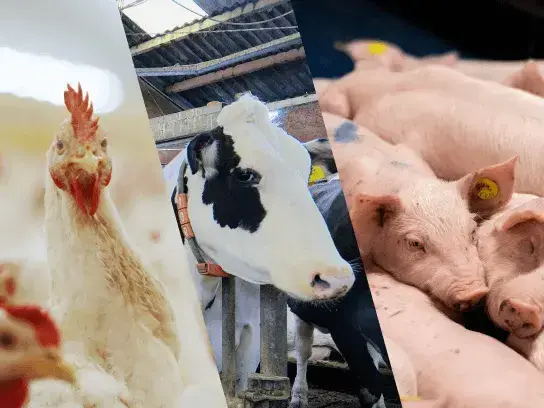- Cattle
- Dairy cattle
- 2 minutes read
Imagine increasing your dairy farm’s milk yield by 7%—an impressive boost achieved simply by upgrading your lighting system. Continue reading to find out more.
In collaboration with Gijs Hendriks of Van Grinsven Agritechniek en Advies, we conducted a comprehensive research study in Overloon, in the barn of Martijn van Raaij, to further understand the effects of RUDAX lighting on dairy cows.
The findings were not only promising but exceeded our expectations.
 Our research showed that RUDAX lighting outperformed traditional lighting methods.
Our research showed that RUDAX lighting outperformed traditional lighting methods.
The research was meticulously structured in two parts. The first part focused on observing the milk production of the dairy cows, while the second part examined their behavior under different lighting conditions. To ensure accurate results, we tracked the participation days of cows that were dried off or were set to calve midway through the study. If it was not feasible to track their participation, their milk production data was excluded. However, if tracking was possible, the cows were evenly distributed into groups post-calving.
(3)-Cover.webp?width=760&height=428&name=0620%20(1)(3)-Cover.webp)
The first part of the study observed the progression of milk production under varying conditions of light distribution and color. This investigation was divided into two six-week periods. During the first six-week period, the RUDAX system was set to achieve white light (4,000K) with an even distribution of 275-200 Lux. In contrast, the existing lighting in the barn maintained the same white light (4,000K) but with an uneven distribution of 400-150 Lux. This setup allowed us to investigate the influence of evenly distributed light on milk production. In the second six-week period, the RUDAX lamp was adjusted to emit blue light (10,000K), while all other conditions remained constant. This phase aimed to determine the impact of blue light on milk production.
The second part of the study focused on observing the cows' behavior under the same two lighting conditions. The research aimed to understand whether the color and distribution of light affected not only milk production but also the cows' lying hours in the cubicles.
(2)-Cover.webp?width=760&height=428&name=0620%20(1)(2)-Cover.webp)
Before implementing RUDAX lighting, Martijn van Raaij's barn used fluorescent lamps and LED lighting. The existing LED lighting was retained for comparison purposes. The results of our study were remarkable. On the side of the barn equipped with RUDAX blue light alone, we observed a 7% increase in milk production.
Martijn reported not only increased productivity but also an improved working environment under these lights. The positive outcomes and excellent collaboration with HATO have inspired us to extend these benefits to other dairy farmers.
At HATO, partnership is key. We believe that research should form the basis of our products. That’s why we value collaborations with partners like Van Grinsven Agritechniek en Advies. Working together allows us to refine our research on the effects of our lighting, improve our products, and share our knowledge with the farming community. We grow with our partners, ensuring that every step forward benefits the entire agricultural industry.
Are you aiming to improve animal welfare and company results? Get in touch with us here.
Let’s improve together!
More success
Happy partners and farmers inspire us. We’re very pleased to share their experiences with you.
Cattle
Boosting Milk Yields with RUDAX Lighting in Bosnia
David Jokic, a dedicated farmer from Prnjavar, Bosnia and Herzegovina, operates a third-generation family farm managing a herd of 150 cattle, which includes...
Cattle
Transforming Dairy Farms in Bosnia: The Impact of HATO and Probico
Between 03-07 March 2025, Probico, a leading supplier of agricultural equipment in Bosnia and Herzegovina, hosted HATO Agricultural Lighting. Probico has been...
At HATO, we think high-quality lighting solutions, designed to enhance animal welfare and livestock production, must be accessible and affordable for all farmers.
Success Stories
Five Years, Zero Replacements: Why CORAX Is George Navaro’s Lighting of Choice
Herman Kusters: I would definitely recommend RUDAX

.webp)
.webp)

